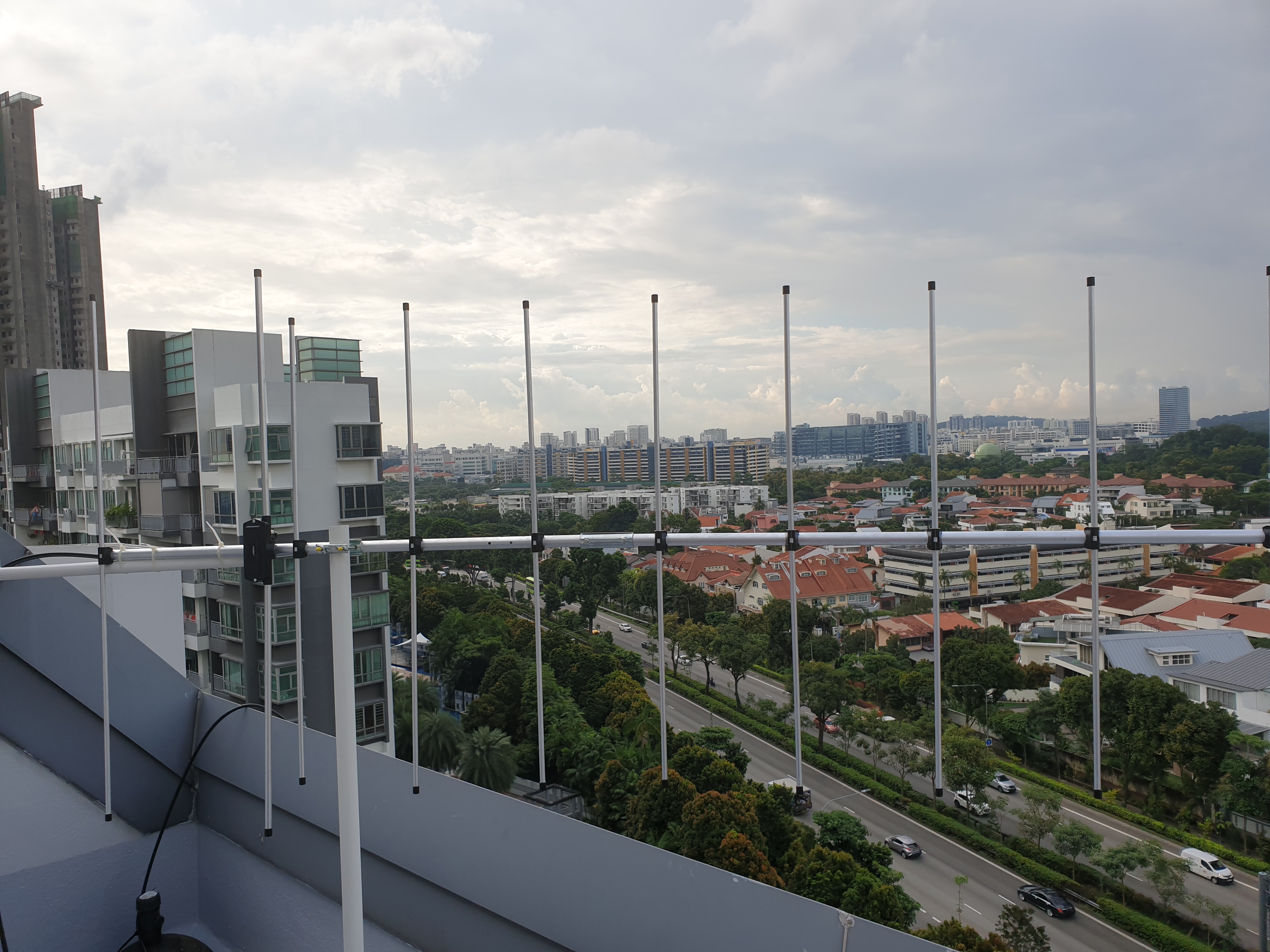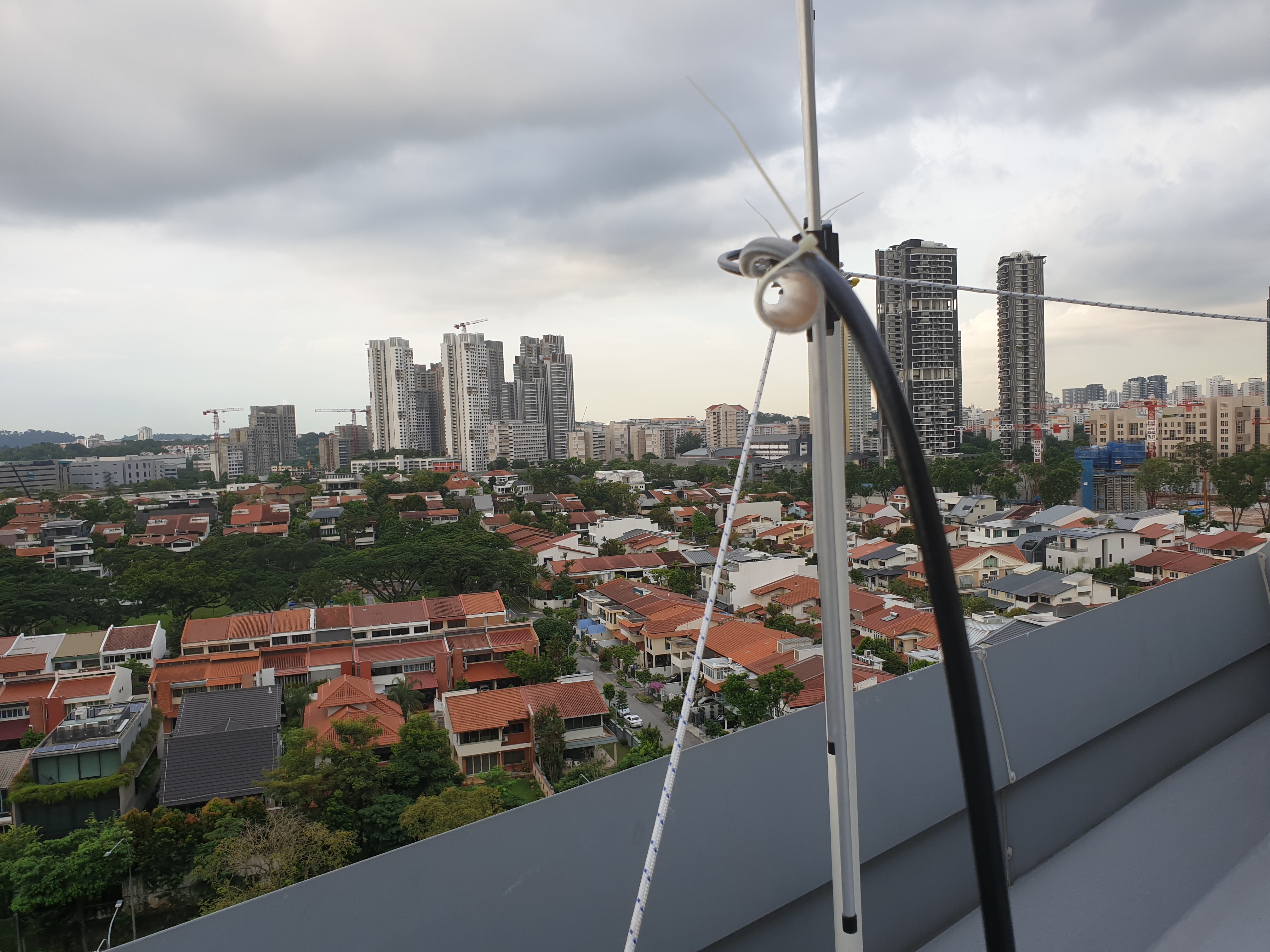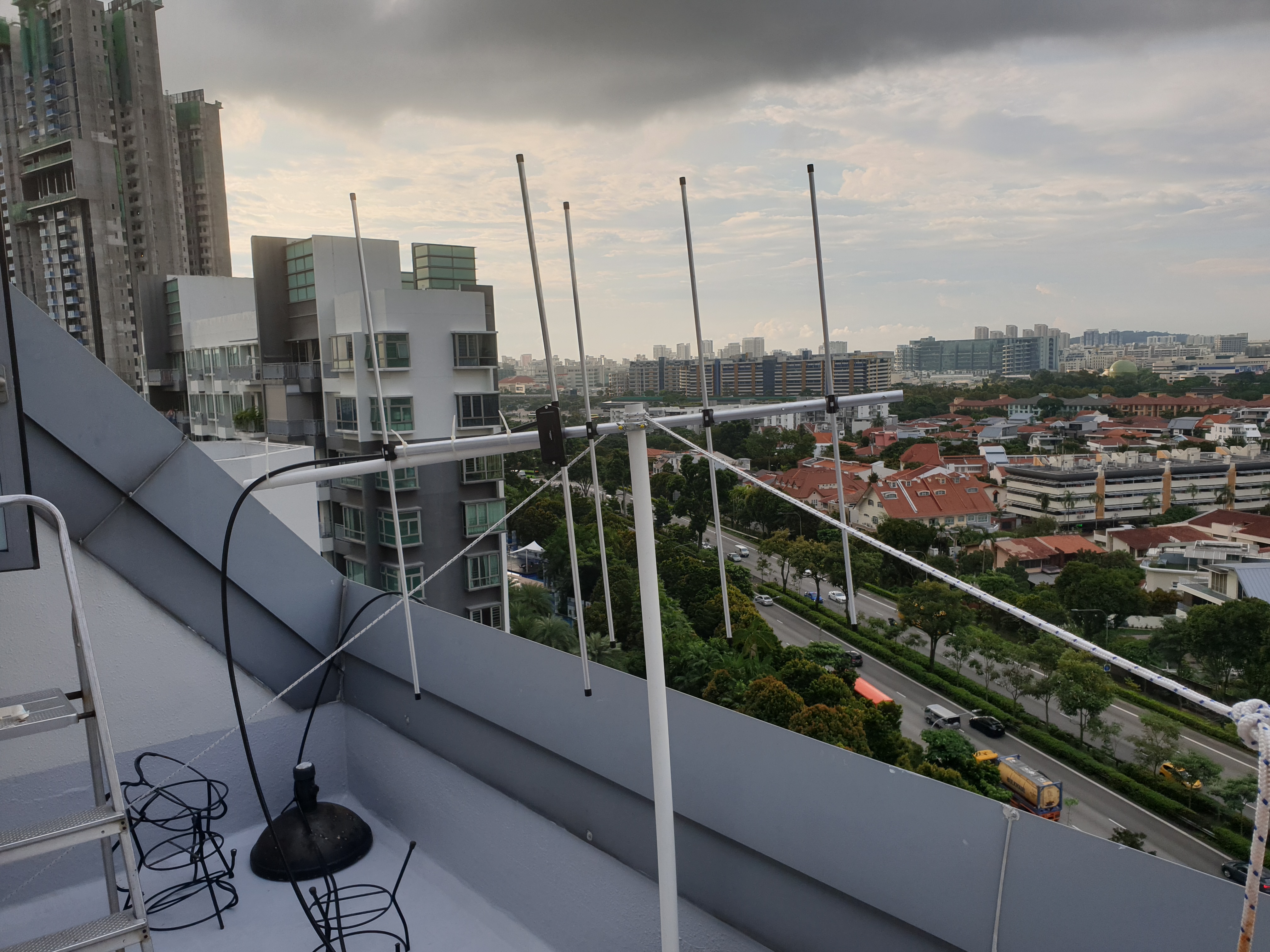As planned, our new duplexer has made it possible for us to resume work on antenna configuration. We're particularly concerned about improving gain and therefore coverage to the east and realised that a short yagi might improve coverage for a large part of Singapore.
Background
We demonstrated in November that a collinear antenna at the upper balcony provides excellent coverage, however the length of the collinear means that it is exposed to lightning risks so installation is likely to require the services of a lightning protection engineer and additional equipment. We worked around this problem by deploying the same antenna on the lower balcony on the basis that if it is inadequate then we'd undertake the lightning protection work required for deployment on the upper balcony. This is starting to look as though it will be necessary. As this process will be time-consuming, we're also exploring other options for improving gain in the interim. Yesterday we tested and switched to a yagi. The results appear to be generally good.
Complicating all of this is that half-duplex tests don't necessarily predict results when operating in full-duplex, as the repeater does. A little over a month ago we finally determined that it was appropriate to replace our old duplexer. We installed the new one about a week ago. This did not solve all outstanding problems of course, but it did set the stage for meaningful testing in full-duplex mode. Naturally we have yet another problem (there's always one more...): the new duplexer appears to have an unreasonably high VSWR. We've approached the reseller to start the process to resolve this and in the meantime have worked around it by inserting a 3dB attenuator in the line between the radio's TX port and the duplexer's high pass port. Quantitatively: Icom specifies that the transmitter not be subjected to a VSWR exceeding 1.5 while Sinclair also happens to specify that their duplexer will present a VSWR not exceeding 1.5. Inconveniently the latter is currently presenting a 2.3 VSWR, which corresponds to a return loss of ~8dB. Inserting the 3dB attenuator increases the return loss by 6dB to ~14dB (3dB reduction in forward power to the duplexer and antenna plus 3dB reduction in power reflected by the duplexer and antenna), for a VSWR very close to 1.5. This is more marginal than I'd like, but is at least within rounding error of Icom's specification.
Experiment
In the meantime, we'd like to increase gain on the upper balcony without incurring unacceptable lightning risks. James 9V1YC hit on the idea of using small yagi and I happened to have one in my storeroom, so yesterday Harish 9V1HP and I installed it. As with the various tests performed during the installation of the duplexer, we also conducted a series of blind tests with the following results.
N.B. In contrast to the tests performed on the weekend, most of the configurations tested yesterday are not feasible for immediate unattended deployment, they were included only as data points to help us understand the situation. They are shown with a red background.
| Configuration | 9V1ZV (pre-amp) | 9V1ZV Buona Vista | 9V1KT Kallang | 9V1KG Bedok | 9V1PL East Coast | 9M2LXM Johor | 9V1CD Bedok |
|---|---|---|---|---|---|---|---|
| 1 | S9+1seg | S6 (about 5seg/S-unit up to S9) | S9+20dB Hiss on background audio. | Nothing | 0, S0 | S9 + 2db | |
| 2 | S9+2seg | S6.5 | S9+40dB Hiss on background audio but still better than in (1). | Nothing | 5, S6 | S9 + 3db | |
| 3 | S9+20dB | S9+4seg (10dB/5seg above S9) | S9+40dB Full quieting. Excellent copy. | S2 (not readable) | 5, S9 Full quieting | S9 + 4db | |
| 4 | S9+16dB | S9+3seg | S9+40dB Full quieting. Excellent copy. No apparent difference from (3). | S2.5 Just can hear signal & modulation, but barely readable | 5, S9+20 Full quieting ++ | S9 + 2db | |
| 5 | S9+4seg | S7.5 | S9+40 R5 Some hiss on the background. | S3 (between 4 & 5 I adj my antenna pos) | R1, S0 | S9 + 4db | |
| 6 | S9+2seg | S6.5 | S9+40 R5 Some hiss on the background. Audio appears to be louder than in (5) but hiss remains as like in (5). | S2 to 2.5 | R1, S-1 | S9 + 2db | |
| 7 | S9+20dB | S9+4seg | S9+40 R5 Very minimal hiss as compared to (5) and (6). Overall better than (5) and (6). | S3 | 5, S9 +20 Full quieting | S9 +6db | |
| 8 | S9+21dB | S9+10dB+ (5seg) | S9+40 R5 Same as results as in (7). Unable to tell the difference between (7) and (8) | S3.5 to 4 | 5, S8 Full quieting | S9+10db | |
| 9 | S9+40dB R5 Minimal hissing | S3 | 5, S7 Full quieting | S9 +1db | S3 | ||
| 10 | S9+40dB R5 Minimal hissing just like (9). However, overall audio slightly louder | S2 to 2.5 | 5, S6 hissing | S9 | S3 | ||
| 11 | S9+40dB R5 Minimal hissing. No apparent difference from (9) and (10). | S2 Hard to read | 5, S9 Full quieting | S9 +3 | cutting out |
It would appear that for most reporting stations, the results were excellent. The marginal stations were 9V1KG, 9V1PL, and 9V1CD. For these stations:
- 1 was unworkable
- 4 and 11 were a little better than 10.
- Not reflected in the reports, Arnold 9V1CD was able to hold the repeater for the most part in configuration 11.
The tested configurations were as follows:
- 25W half-yagi 90deg
- 50W half-yagi 90deg
- 50W half-yagi 45deg
- 25W half-yagi 45deg
- 50W full-yagi 90deg
- 25W full-yagi 90deg
- 25W full-yagi 45deg
- 50W full-yagi 45deg
- 50W unity
- 25W unity
- 25W half-yagi 45deg (same as 4)
Notes:
- In all cases the antenna was on the upstairs balcony.
- The power level is out of the transmitter, but there's temporarily a 3dB attenuator in place to protect the transmitter from excessive duplexer VSWR. The 50W configurations were tested to allow us to see likely performance once this is resolved, however if we leave it at 50W in the interim then it will tend to throttle itself a lot. For that reason all 50W configurations were flagged as infeasible.
- full-yagi means a Diamond A144S10R. This is long enough as to both be difficult to secure and to protrude into lightning risks.
 This would have been easier to photograph if I'd brought my spherical camera with me again...
This would have been easier to photograph if I'd brought my spherical camera with me again... - half-yagi means the back half of the same antenna (reflector, driver, three directors). This configuration should perform similarly to the A144S5 (also described in the same installation instructions) and has the benefit that it can be left unattended the upper balcony.
- unity means the quarter-wave ground-plane antenna that was in transmit-only use prior to yesterday.
- 90deg means the yagi perpendicular to the building or north-east (42° magnetic).
- 45deg means the yagi 45° CW from perpendicular or east (87° magnetic).
 View along the beam as deployed.
View along the beam as deployed. - The only feasible unattended-use configurations at present are 1, 4/11, and 10.
Outcome
We left the antenna in configuration 4/11 for the time being.
Discussion
As is hopefully obvious, there is a dilemma here:
- Pointing the antenna NE was unworkable for the marginal stations.
- Pointing the antenna E was workable for those stations, however Aaron 9V1AW (Woodlands) and Amos 9V1HH (Tiong Bahru?) have separately reported workable service in 10, but nothing at all in 11.
10 is a bit of a mystery. It's essentially the transmit configuration that we've been running since the move, but with reception through the duplexer from the same antenna. It looks as though this might benefit from further exploration.
Adding directionality has solved a large problem (coverage for a swathe of Singapore to the east), but at the cost of lost service for at least two previously working stations to the north and south of the repeater. I suspect that the tradeoff is worthwhile, but we need to keep in mind that it is a tradeoff.
Next steps
- I'd suggest that the above should be digested and understood by anyone who's interested in this. In particular, gain-by-yagi is helpful, but has a built-in dilemma that means choosing who gets to use it. This is potentially sensitive issue.
- We're working with the local reseller to get the new duplexer issue resolved ASAP.
- We need good data on the use of the collinear antenna on the upper balcony with the duplexer, and will test this shortly. If this materially improves service then we'll need to start the work with an engineer licensed to perform lightning-protection work in Singapore so we can eventually install it for unattended operation. If you know someone who might be willing to undertake this work pro bono, or at a minimal cost, please say so! If you know comms engineers who work with people with this expertise (they'll need it for any rooftop antenna installations), then please consider sounding them out.
- The argument for multiple repeaters hasn't gone away. A dense urban environment has shadow and multipath issues everywhere, even the radio-quiet mountain-top site for the Johor repeater can't reach all of Singapore. Our basic problem here remains hosting sites (equipment, operation, and licensing can all be solved more easily). If you have a balcony or similar with a view and are willing to host a repeater then please say so!

